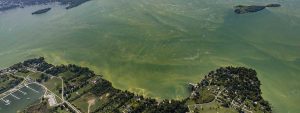

Abu Dhabi: A team of scientists including NYU Abu Dhabi Assistant Professor of Biology Shady Amin has been awarded a National Oceanic and Atmospheric Administration (NOAA) grant worth $4,999,505.
This grant will fund a five-year study to examine the roles various physical and biological factors play in intensifying and prolonging harmful algal blooms that occur annually off the Florida coast’s Gulf of Mexico (GoM) and the processes that lead to bloom termination. Harmful algal blooms (HABs) are phenomena that are increasingly observed in coastal waters throughout the world and are caused by the rapid growth of certain species of microscopic phytoplankton (single-celled algae) that are part of the normal composition of aquatic ecosystems. This rapid growth coupled with often toxin production by these algae causes major environmental, economic and health problems in coastal areas and current efforts by scientists and governmental agencies strive to understand the causes and ways to mitigate them.
The research team will accomplish these goals using climate and oceanographic modelling, laboratory experiments on model systems and data collected aboard several research cruises that will take place in the next five years. The multi-disciplinary team includes scientists from several institutions, including Cynthia Heil (Mote Marine Laboratory, Florida), Joaquin Martinez (Bigelow Marine Laboratory, Maine), Katherine Hubbard (Fish and Wildlife Research Institute, Florida), Robert Weisberg (University of South Florida), and Ming Li and Patricia Gilbert (University of Maryland).
Commenting on the grant, Amin said, “For the first time, this is a major effort supported by the US government that involves microbiologists, virologists, chemists, modellers and governmental monitoring agencies to tackle the annual blooms plaguing the US coastline. Being the only scientist on this highly competitive grant from outside the US is also a testament to the wonderful research taking place here at NYUAD. Understanding the factors influencing these blooms in the GoM will have direct application to blooms occurring here in the Arabian Gulf and the Gulf of Oman and perhaps some of our findings and solutions can be applied here in the future.”
Amin brings extensive experience in marine microbiology, phytoplankton ecology and metabolomics (Metabolomics is the large-scale study of small molecules). His research lab focuses on understanding microbial symbioses in aquatic environments with a strong emphasis on how microbiomes of eukaryotes [organisms with clearly defined nuclei] influence cell physiology and evolution. His work also examines why and how harmful algal species proliferate in the Arabian Gulf and beyond.
SHARJAH, (6 July 2025) – The Sharjah Media Academy, part of the Sharjah Broadcasting Authority…
SHARJAH, 6 July 2025 (WAM) – Dibba Al-Hisn Municipality, in cooperation with Sharjah Municipality, has…
OSAKA, Japan, 6 July 2025 (WAM) — Jasem Mohamed Albudaiwi, Secretary-General of the Gulf Cooperation…
DUBAI, United Arab Emirates (July 6, 2025) — Dubai’s Roads and Transport Authority (RTA) has…
By H.E. Saeed Mohammed Al Tayer, MD & CEO of DEWA DUBAI, United Arab Emirates…
AL AIN, July 5, 2025 — The second edition of Al Ain Summer Sports (AASS)…